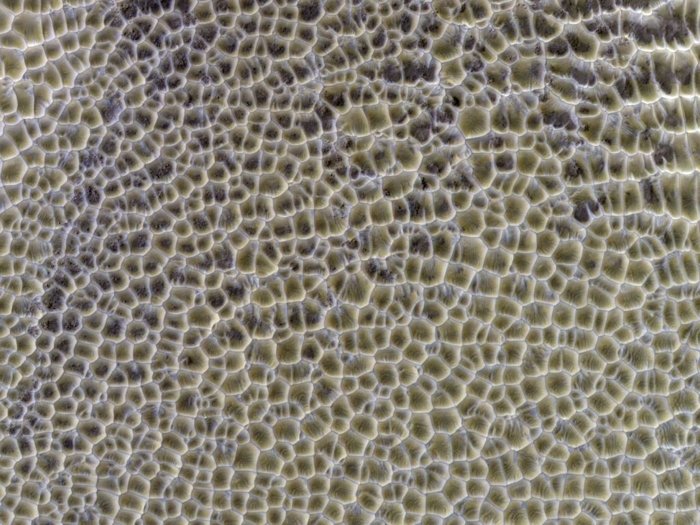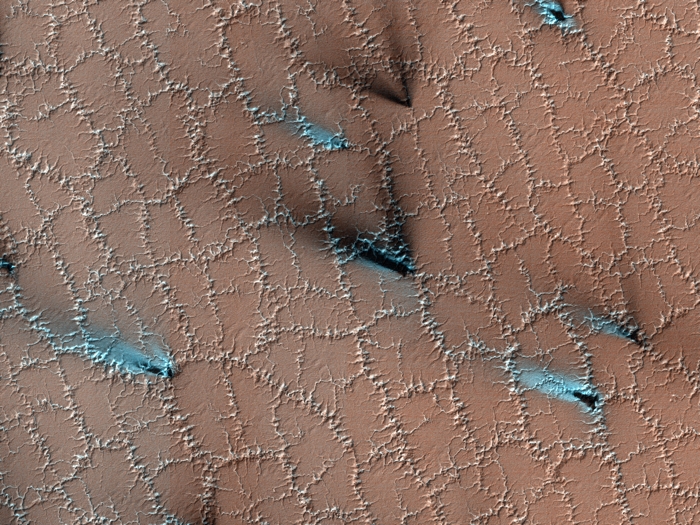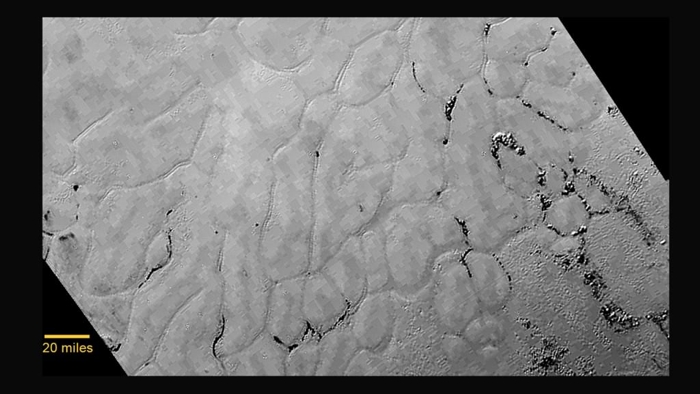Science
Strange Honeycomb Pattern on Mars Appears to Be Formed by Water Ice And CO2 – ScienceAlert

From orbit, this landscape on Mars looks like a lacy honeycomb or a spider web. But the unusual polygon-shaped features aren’t created by Martian bees or spiders; they are actually formed from an ongoing process of seasonal change from created from water ice and carbon dioxide.
The HiRISE camera (High Resolution Imaging Science Experiment) on the Mars Reconnaissance Orbiter has seen a lot of polygon shapes in the years since 2006 when it went into orbit of Mars.
(NASA/JPL/UArizona)
Above: Polygonal dunes on Mars, as seen by the HiRISE camera on the Mars Reconnaissance Orbiter.
The science team from HiRISE says that both water and carbon dioxide in the solid form of dry ice play a major role in sculpting Mars’ surface at high latitudes.
Water ice frozen in the soil splits the ground into the polygon shapes. Then, dry ice sublimating from just under the surface when the ground warms in the spring creates even more erosion, creating channels around the boundaries of the polygons.


Above: Spring fans and polygons on Mars, as seen by the HiRISE camera on the Mars Reconnaissance Orbiter.
The polygons form over many years as the near-surface ice contracts and expands seasonally.
But this polygon-covered region shows even more springtime activity, evidenced by the blue fan-shaped features. Scientists say the layer of translucent dry ice coating the surface develops vents that allow gas to escape.
“The gas carries along fine particles of material from the surface further eroding the channels,” the team wrote on the HiRISE website.
“The particles drop to the surface in dark fan-shaped deposits. Sometimes the dark particles sink into the dry ice, leaving bright marks where the fans were originally deposited. Often the vent closes, then opens again, so we see two or more fans originating from the same spot but oriented in different directions as the wind changes.”


Above: Detailed image of large-scale crater floor polygons, caused by desiccation process, with smaller polygons caused by thermal contraction inside. The central polygon is 160 meters in diameter, smaller ones range 10 to 15 meters in width and the cracks are 5 -10 meters across.
Scientists study polygonally-patterned ground on Mars because these features help them understand the recent and past distribution of ices in the shallow subsurface, as well as provide clues about climate conditions.
And Mars isn’t the only place with polygons. Polygons can be found in Earth’s arctic and Antarctic regions, and the 2015 flyby by the New Horizons spacecraft revealed polygons on Pluto as well.


Above: Polygons seen on Pluto.
In the center left of Pluto’s vast heart-shaped feature – informally named “Tombaugh Regio” – lies a vast, crater-less plain that appears to be no more than 100 million years old, and is possibly still being shaped by geologic processes.
This frozen region is north of Pluto’s icy mountains and has been informally named Sputnik Planum (Sputnik Plain), after Earth’s first artificial satellite. The surface appears to be divided into polygon-shaped segments that are ringed by narrow troughs.
Features that appear to be groups of mounds and fields of small pits are also visible. This image was acquired by the Long Range Reconnaissance Imager (LORRI) on July 14 from a distance of 48,000 miles (77,000 kilometers).
Features as small as one-half mile (1 kilometer) across are visible. The blocky appearance of some features is due to compression of the image.
This article was originally published by Universe Today. Read the original article.
Science
Marine plankton could act as alert in mass extinction event: UVic researcher – Langley Advance Times


A University of Victoria micropaleontologist found that marine plankton may act as an early alert system before a mass extinction occurs.
With help from collaborators at the University of Bristol and Harvard, Andy Fraass’ newest paper in the Nature journal shows that after an analysis of fossil records showed that plankton community structures change before a mass extinction event.
“One of the major findings of the paper was how communities respond to climate events in the past depends on the previous climate,” Fraass said in a news release. “That means that we need to spend a lot more effort understanding recent communities, prior to industrialization. We need to work out what community structure looked like before human-caused climate change, and what has happened since, to do a better job at predicting what will happen in the future.”
According to the release, the fossil record is the most complete and extensive archive of biological changes available to science and by applying advanced computational analyses to the archive, researchers were able to detail the global community structure of the oceans dating back millions of years.
A key finding of the study was that during the “early eocene climatic optimum,” a geological era with sustained high global temperatures equivalent to today’s worst case global warming scenarios, marine plankton communities moved to higher latitudes and only the most specialized plankton remained near the equator, suggesting that the tropical temperatures prevented higher amounts of biodiversity.
“Considering that three billion people live in the tropics, the lack of biodiversity at higher temperatures is not great news,” paper co-leader Adam Woodhouse said in the release.
Next, the team plans to apply similar research methods to other marine plankton groups.
Read More: Global study, UVic researcher analyze how mammals responded during pandemic
Science
Scientists Say They Have Found New Evidence Of An Unknown Planet… – 2oceansvibe News


In the new work, scientists looked at a set of trans-Neptunian objects, or TNOs, which is the technical term for those objects that sit out at the edge of the solar system, beyond Neptune
The new work looked at those objects that have their movement made unstable because they interact with the orbit of Neptune. That instability meant they were harder to understand, so typically astronomers looking at a possible Planet Nine have avoided using them in their analysis.
Researchers instead looked towards those objects and tried to understand their movements. And, Dr Bogytin claimed, the best explanation is that they result from another, undiscovered planet.
The team carried out a host of simulations to understand how those objects’ orbits were affected by a variety of things, including the giant planets around them such as Neptune, the “Galactic tide” that comes from the Milky Way, and passing stars.
The best explanation was from the model that included Planet 9, however, Dr Bogytin said. They noted that there were other explanations for the behaviour of those objects – including the suggestion that other planets once influenced their orbit, but have since been removed – but claim that the theory of Planet 9 remains the best explanation.
A better understanding of the existence or not of Planet 9 will come when the Vera C Rubin Observatory is turned on, the authors note. The observatory is currently being built in Chile, and when it is turned on it will be able to scan the sky to understand the behaviour of those distant objects.
Planet Nine is theorised to have a mass about 10 times that of Earth and orbit about 20 times farther from the Sun on average than Neptune. It may take between 10,000 and 20,000 Earth years to make one full orbit around the Sun.
You may be tempted to ask how an entire planet could ‘hide’ in our solar system when we have zooming capabilities such as the new iPhone 15 has, but consider this: If Earth was the size of a marble, the edge of our solar system would be 11 kilometres away. That’s a lot of space to hide a planet.
[source:independent]
Science
Dragonfly: NASA Just Confirmed The Most Exciting Space Mission Of Your Lifetime – Forbes


NASA has confirmed that its exciting Dragonfly mission, which will fly a drone-like craft around Saturn’s largest moon, Titan, will cost $3.35 billion and launch in July 2028.
Titan is the only other world in the solar system other than Earth that has weather and liquid on the surface. It has an atmosphere, rain, lakes, oceans, shorelines, valleys, mountain ridges, mesas and dunes—and possibly the building blocks of life itself. It’s been described as both a utopia and as deranged because of its weird chemistry.
Set to reach Titan in 2034, the Dragonfly mission will last for two years once its lander arrives on the surface. During the mission, a rotorcraft will fly to a new location every Titan day (16 Earth days) to take samples of the giant moon’s prebiotic chemistry. Here’s what else it will do:
- Search for chemical biosignatures, past or present, from water-based life to that which might use liquid hydrocarbons.
- Investigate the moon’s active methane cycle.
- Explore the prebiotic chemistry in the atmosphere and on the surface.
Spectacular Mission
“Dragonfly is a spectacular science mission with broad community interest, and we are excited to take the next steps on this mission,” said Nicky Fox, associate administrator of the Science Mission Directorate at NASA Headquarters in Washington. “Exploring Titan will push the boundaries of what we can do with rotorcraft outside of Earth.”
It comes in the wake of the Mars Helicopter, nicknamed Ingenuity, which flew 72 times between April 2021 and its final flight in January 2023 despite only being expected to make up to five experimental test flights over 30 days. It just made its final downlink of data this week.
Dense Atmosphere
However, Titan is a completely different environment to Mars. Titan has a dense atmosphere on Titan, which will make buoyancy simple. Gravity on Titan is just 14% of the Earth’s. It sees just 1% of the sunlight received by Earth.
function loadConnatixScript(document)
if (!window.cnxel)
window.cnxel = ;
window.cnxel.cmd = [];
var iframe = document.createElement(‘iframe’);
iframe.style.display = ‘none’;
iframe.onload = function()
var iframeDoc = iframe.contentWindow.document;
var script = iframeDoc.createElement(‘script’);
script.src = ‘//cd.elements.video/player.js’ + ‘?cid=’ + ’62cec241-7d09-4462-afc2-f72f8d8ef40a’;
script.setAttribute(‘defer’, ‘1’);
script.setAttribute(‘type’, ‘text/javascript’);
iframeDoc.body.appendChild(script);
;
document.head.appendChild(iframe);
loadConnatixScript(document);
(function()
function createUniqueId()
return ‘xxxxxxxx-xxxx-4xxx-yxxx-xxxxxxxxxxxx’.replace(/[xy]/g, function(c) 0x8);
return v.toString(16);
);
const randId = createUniqueId();
document.getElementsByClassName(‘fbs-cnx’)[0].setAttribute(‘id’, randId);
document.getElementById(randId).removeAttribute(‘class’);
(new Image()).src = ‘https://capi.elements.video/tr/si?token=’ + ’44f947fb-a5ce-41f1-a4fc-78dcf31c262a’ + ‘&cid=’ + ’62cec241-7d09-4462-afc2-f72f8d8ef40a’;
cnxel.cmd.push(function ()
cnxel(
playerId: ’44f947fb-a5ce-41f1-a4fc-78dcf31c262a’,
playlistId: ‘aff7f449-8e5d-4c43-8dca-16dfb7dc05b9’,
).render(randId);
);
)();
The atmosphere is 98% nitrogen and 2% methane. Its seas and lakes are not water but liquid ethane and methane. The latter is gas in Titan’s atmosphere, but on its surface, it exists as a liquid in rain, snow, lakes, and ice on its surface.
COVID-Affected
Dragonfly was a victim of the pandemic. Slated to cost $1 billion when it was selected in 2019, it was meant to launch in 2026 and arrive in 2034 after an eight-year cruise phase. However, after delays due to COVID, NASA decided to compensate for the inevitable delayed launch by funding a heavy-lift launch vehicle to massively shorten the mission’s cruise phase.
The end result is that Dragonfly will take off two years later but arrive on schedule.
Previous Visit
Dragonfly won’t be the first time a robotic probe has visited Titan. As part of NASA’s landmark Cassini mission to Saturn between 2004 and 2017, a small probe called Huygens was despatched into Titan’s clouds on January 14, 2005. The resulting timelapse movie of its 2.5 hours descent—which heralded humanity’s first-ever (and only) views of Titan’s surface—is a must-see for space fans. It landed in an area of rounded blocks of ice, but on the way down, it saw ancient dry shorelines reminiscent of Earth as well as rivers of methane.
The announcement by NASA makes July 2028 a month worth circling for space fans, with a long-duration total solar eclipse set for July 22, 2028, in Australia and New Zealand.
Wishing you clear skies and wide eyes.
-



 Investment23 hours ago
Investment23 hours agoUK Mulls New Curbs on Outbound Investment Over Security Risks – BNN Bloomberg
-
Media2 hours ago
DJT Stock Rises. Trump Media CEO Alleges Potential Market Manipulation. – Barron's
-



 Sports22 hours ago
Sports22 hours agoAuston Matthews denied 70th goal as depleted Leafs lose last regular-season game – Toronto Sun
-
Business21 hours ago
BC short-term rental rules take effect May 1 – CityNews Vancouver
-
Media4 hours ago
Trump Media alerts Nasdaq to potential market manipulation from 'naked' short selling of DJT stock – CNBC
-
Art20 hours ago
Collection of First Nations art stolen from Gordon Head home – Times Colonist
-



 Investment20 hours ago
Investment20 hours agoBenjamin Bergen: Why would anyone invest in Canada now? – National Post
-



 Tech23 hours ago
Tech23 hours agoSave $700 Off This 4K Projector at Amazon While You Still Can – CNET






